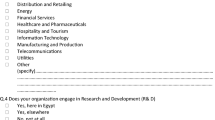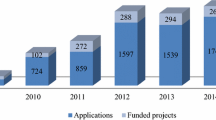Abstract
Academic entrepreneurship has been intensively applied to the area of technology innovation and diffusion in the US. Along with the promotion of innovative approaches, universities take advantage of knowledge spillovers from their laboratories to the market for both economic development and financial gains. This study assessed individual university productivity in technology transfer using feasible measures of multiple input–output combinations and data envelopment analysis to examine panel data gathered over the period 1999–2007. A major finding is that there was substantial growth in the average productivity of university technology transfer during this period. The average annual productivity gain in the 90 universities was over 30%, indicating that universities’ technology transfer activities were relatively efficient in terms of their input to output ratio. The positive shifts in average productivity changes were primarily due to the increasing frequencies of commercial outputs. This finding suggests that universities and public policy should pay attention to stimulate commercial activities rather than to increase investments for upgrading a next level of realistic, long-term strategies.
Similar content being viewed by others
References
Adams, J. D., & Griliches, Z. (1998). Research productivity in a system of universities. Annuals of INSEE, 49(50), 127–162.
Agrawal, A. (2001). University-to-industry knowledge transfer: Literature review and unanswered questions. International Journal of Management Reviews, 3(4), 285–302.
Anderson, T. R., Daim, T. U., & Lavoie, F. F. (2007). Measuring the efficiency of university technology transfer. Technovation, 27, 306–318.
Association of University Technology Managers. (2007). US licensing activity survey: FY 2006. Northbrook, IL: Association of University Technology Managers, Inc.
Banker, R. D., Charnes, A., & Cooper, W. W. (1984). Some models for estimating technical and scale inefficiencies in data envelope analysis. Management Science, 30(9), 1078–1092.
Bercovitz, J., & Feldmann, M. (2006). Entrepreneurial universities and technology transfer: A conceptual framework for understanding knowledge-based economic development. Journal of Technology Transfer, 31, 175–188.
Bercovitz, J., Feldmann, M., Feller, I., & Burton, R. (2001). Organizational structure as a determinant of academic patenting and licensing behavior: An exploratory study of Duke, Johns Hopkins, and Pennsylvania State Universities. Journal of Technology Transfer, 26, 21–135.
Bozeman, B. (2000). Technology transfer and public policy: A review of research and theory. Research Policy, 29, 627–655.
Carlsson, B., & Fridh, A. C. (2002). Technology transfer in United States universities: A survey and statistical analysis. Journal of Evolutionary Economics, 12(1–2), 199–232.
Chapple, W., Lockett, A., Siegel, D., & Wright, M. (2005). Assessing the relative performance of UK university technology transfer offices: Parametric and non-parametric evidence. Research Policy, 34(3), 369–384.
Charnes, A., Cooper, W. W., & Rhodes, E. (1978). Measuring the efficiency of decision making units. European Journal of Operational Research, 2, 429–444.
Colyvas, J., Crow, M., Gelijns, A., Mazzoleni, R., Nelson, R., Rosenberg, N., et al. (2002). How do university inventions get into practice? Management Science, 48(1), 61–72.
Di Gregorio, D., & Shane, S. (2003). Why do some universities generate more start-ups than others? Research Policy, 32, 209–227.
Etzkowitz, H. (1998). The norms of entrepreneurial science: Cognitive effects of the new university-industry linkages. Research Policy, 27, 823–833.
Etzkowitz, H. (2002). MIT and the rise of entrepreneurial science. New York, NY: Routledge.
Färe, R., Grosskopf, S., Lindgren, B., & Roos, P. (1992). Productivity change in Swedish pharmacies 1980–1989: A non-parametric Malmquist approach. Journal of Productivity Analysis, 3(1–2), 85–102.
Färe, R., Grosskopf, S., & Lovell, C. (1994). Production frontiers. New York, NY: Cambridge University Press.
Farrell, M. J. (1957). The measurement of productive efficiency. Journal of Royal Statistical Society Series A (General), 120(part 3), 253–281.
Friedman, J., & Silberman, J. (2003). University technology transfer: Do incentives, management, and location matter? Journal of Technology Transfer, 28, 17–30.
Jacobs, R., Smith, P. C., & Street, A. (2006). Measuring efficiency in health care. Analytic techniques and health policy. New York, NY: Cambridge University Press.
Jensen, R., & Thursby, M. (2001). Proofs and prototypes for sale: The licensing of university inventions. American Economic Review, 91(1), 240–259.
Mille, M. (2004). The university, knowledge spillovers and local development: The experience of a new university. Higher Education Management & Policy, 16(3), 77–100.
Mowery, D. C., Nelson, R. R., Sampat, B. N., & Ziedonis, A. A. (2004). Ivory tower and industrial innovation. University-industry technology transfer before and after the Bayh-Dole Act in the United States. Stanford, CA: Stanford University Press.
National Science Board. (2010). Science and Engineering Indicators 2010. Arlington, VA: National Science Foundation (NSB 10–01).
O’Shea, R. P., Allen, T. J., Chevalier, A., & Roche, F. (2005). Entrepreneurial orientation, technology transfer, and spin-off performance of US universities. Research Policy, 34(7), 994–1009.
Phan, P. H., & Siegel, D. S. (2006). Effectiveness of technology transfer. Foundation and Trends in Entrepreneurship, 2(2), 77–144.
Ray, S. C. (2004). Data envelopment analysis: Theory and techniques for economics and operations research. New York, NY: Cambridge University Press.
Rogers, E. M., Takegami, S., & Yin, J. (2001). Lessons learned about technology transfer. Technovation, 21, 253–261.
Seiford, L. M. (1996). Data envelopment analysis: The evolution of state of the art (1978–1995). Journal of Production Analysis, 7, 99–137.
Shane, S. (2004). Academic entrepreneurship: University spinoffs and wealth creation. Northampton, MA: Edward Elgar Publishing, Inc.
Siegel, D. S., Waldman, D. A., Atwater, L. E., & Link, A. N. (2004). Toward a model of the effective transfer of scientific knowledge from academicians to practitioners: Qualitative evidence from the commercialization of university technologies. Journal of Engineering & Technology Management, 21, 115–142.
Siegel, D. S., Waldman, D., & Link, A. N. (2003). Assessing the impacts of organizational practices on the relative productivity of university technology transfer offices: An exploratory study. Research Policy, 32(1), 27–49.
Siegel, D. S., & Wright, M. (2007). Intellectual property: The assessment. Oxford Review of Economic Policy, 23(4), 529–540.
Stern, Z. S., Mehrez, A., & Barboy, A. (1994). Academic department efficiency via DEA. Computers & Operations Research, 21(5), 543–556.
Stolp, C. (1990). Strengths and weaknesses of data envelopment analysis: An urban and regional perspective. Computers, Environment and Urban Systems, 14(2), 103–116.
Thursby, J. G., Jensen, R., & Thursby, M. C. (2001). Objectives, characteristics and outcomes of university licensing: A survey of major US universities. Journal of Technology Transfer, 26, 59–72.
Thursby, J. G., & Kemp, S. (2002). Growth and productive efficiency of university intellectual property licensing. Research Policy, 31, 109–124.
Thursby, J. G., & Thursby, M. C. (2002). Who is selling the ivory tower? Sources of growth in university licensing. Management Science, 48(1), 90–104.
Trajtenberg, M., Henderson, R., & Jaffe, A. (1997). University versus corporate patents: A window on the basicness of invention. Economics of Innovation and New Technology, 5(1), 19–50.
US Patent and Trademark Office. (2007). US colleges and universities-utility patent grants 1969–2005. Washington, DC: US.
Zaltman, G., Duncan, R., & Holbek, J. (1973). Innovation and organizations. New York, NY: Wiley.
Zucker, L. G., Darby, M. R., & Armstrong, J. S. (1998). Geographically localized knowledge: Spillovers or markets? Economic Inquiry, 36(1), 65–86.
Author information
Authors and Affiliations
Corresponding author
Appendix
Rights and permissions
About this article
Cite this article
Kim, Y. The ivory tower approach to entrepreneurial linkage: productivity changes in university technology transfer. J Technol Transf 38, 180–197 (2013). https://doi.org/10.1007/s10961-011-9217-8
Published:
Issue Date:
DOI: https://doi.org/10.1007/s10961-011-9217-8




